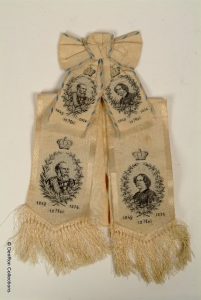
-
THE HISTORY OF THE STEVENGRAPHS (SILK PICTURES)
Stevengraphs are pictures woven from silk, originally created by Thomas Stevens in the 19th century.
Thomas Stevens, a local weaver from Coventry adapted the looms to weave colourful pictures from silk. By 1862, Stevens could produce four different designs and by the late 1880s over 900; they became known as “Stevengraphs”, after their maker. Many of these designs were used to produce bookmarks, while others were used to make greeting cards and other silk objects such as portraits of Royalty, military figures, famous people and even buildings.
By the 1930s, Stevengraphs were considered collectable items, but the hobby was considered eccentric and mainly confined to female collectors.After the war Stevengraphs became valuable, with more male collectors entering the hobby. Prices rose, particularly for unusual or rarer images less popular during the Victorian period.
Silk portraits were also made of members of the Dutch Royal family .HERE ARE SOME FROM OUR COLLECTION:

- silk sash with portraits of King Willem III and his wife Queen Sophie made for their silver jubilee in 1874

- portrait woven in silk of Queen Wilhelmina made in 1898 for her inauguration
- silk bookmark with portraits of Princess Juliana & Prince Bernhard to commemorate their wedding in 1937













